Envisioning the Future of Global Buddhism
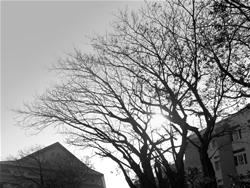
Diverse yet integral, global Buddhism starts from Dharma Drum Mountain World Center for Buddhist Education, based on the content of the Four Kinds of Environmentalism and the quest for The Three Types of Education, using Mahayana Buddhism as the axle.
Environmental Conservation and Construction
A House Built with the Four Kinds of Environmentalism
Many Taiwanese today know that the Dharma Drum Mountain (DDM) World Center for Buddhist Education is in Jinshan Village, Taipei County, by the shore of the north shore of Taiwan. However, in 1989 when Master Sheng Yen proposed "Dharma Drum Mountain" as the name for the newly founded Buddhist center, people were curious and wondered, "What is Dharma Drum Mountain? What does it do?"

At that time, Master Sheng Yen had sketched out a clear plan based on a foundation of education, practice, culture, and charity, as espoused at Nung Chan Monastery, the Chung-Hwa Institute of Buddhist Culture (CHIBC) as well as the Chung-Hwa Institute of Buddhist Studies (CHIBS).
His blueprint would create:
●A global Buddhist educational facility that includes a research institute
●A Buddhist studies institute
●An international Chan meditation center
●An international Dharma teaching center
●A translation and publishing center
●An international Buddhist conference center
●A place for quiet contemplation and practice.
Protecting the Environment as the First Priority
During the first phase of construction in 1991, there were initial obstacles due to strict regulations governing the cultivation of hillsides and some complex land-ownership issues which were eventually resolved. Several years later, DDM obtained its first construction certificate for operating a plant for water purification, emphasizing DDM's first priority: protecting the environment.

Regarding the focus on environmentalism, Master Sheng Yen said:
Environmentalism begins with the spiritual environment, while the spiritual environmentalism is based on the concept of cause and effect in cherishing and nurturing blessing, in the concept of compassion in preserving life, in being kind to others as well as to oneself, in having the wisdom and insight in understanding that protecting nature is beneficial to all sentient beings, including oneself.
From the beginning, principles were clearly laid down to minimize the impact on the natural soil and land while following strict guidelines to ensure safety and legality. Plans for the number and size of the buildings were revised several times to ease pressure on the soil structure, and to ensure that the buildings would blend harmoniously with its surroundings and the natural environment. As well, the hillside was cultivated in stages to soften the overall impact on the land. In addition, structures were designed to help retain water and soil, and a facility to purify waste water was built to avoid polluting the streams and rivers.

During construction, Master Sheng Yen reminded workers to "maintain the original appearance of the site, and treasure the natural resources, such as streams and rivers, as well as trees and grass." He envisioned the scenery of DDM as being harmonious between the man-made structures and the natural environment, just as in a traditional Chinese landscape, a poet's hut is an organic entity in the arms of the nature.
Abundant Natural Resources
The DDM World Center of Buddhist Education is located at the junction of the Danjin, Yangjin, and Jijin highways, surrounded by mountains on three sides. When the sky is clear one can see as far as Green Bay. At the bottom of the mountains lies the peaceful and quiet Jinshan prairie. Nestled among the green mountains and the various buildings are two clear streams. Originally small, the streams were enlarged in the year 2000 by heavy rainfall brought about by a typhoon. From then on, wonderful natural music can be heard day and night as water flows in the streams. Even after more than fifteen years of construction in the surrounding area, these streams remain clear and lively, inhabited by many species of fish, frogs, crabs, and shrimps.
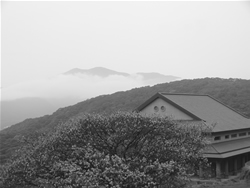
As the seasons change, many wonderful visitors, such as different kinds of birds, arrive. However, the friendliest are definitely the three water buffalos who every so often take a leisurely stroll just outside the grounds of Dharma Drum College of Humanities and Social Sciences, sometimes as a pair and sometimes as a family. Since they allow people to come near, this family has become part of the lives of many of the Buddhist Seminary of Dharma Drum Sangha University students. We are grateful to Mother Earth for blessing DDM with so many natural treasures, and the construction team has worked hard to preserve as many of these treasures as possible.
A Peaceful and Calm Place for Practice
Harmony, Joy, and Freedom at Every Moment
On the grounds of the original monastery at Jinshan there is a very large statue of Guanyin that is very well known in Taiwan. This was precisely the place where Ven. Quandu prayed in 1989 that a new abbot would soon be found. Among a religious group called Yiguandao, were members who dreamed of a very large statue of Guanyin and who searched all over the county for it. When they finally saw the statue of the great bodhisattva at Jinshan, they were overcome with joy and tears: "Yes, yes, this is the Guanyin we dreamed of!" Among Jinshan residents, there were also many stories about miraculous appearances of this bodhisattva in the village.
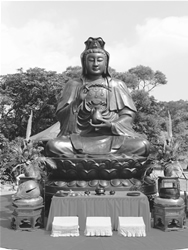
In March 1989, DDM was born amidst vows made by over a thousand people chanting the Great Compassion Mantra and blessed by the Bodhisattva Guanyin. Master Sheng Yen also named the group of mountains leading up to DDM the Double-sided Guanyin Mountain. This is because when looked at from one side the mountain group resembles Guanyin teaching the Dharma, and when looked at from the other side, it resembles Guanyin meditating.
Guanyin Bodhisattva is a very important figure in Mahayana Buddhism, and many people in Far East believe in her powers of great compassion and her great vows. At DDM's annual refuge-taking ceremony, disciples would chant Guanyin's name and at the end of the ceremony, would receive a double-sided pendant, with one side bearing the image of the Buddha and the other side bearing the image of Guanyin. Master Sheng Yen would remind the disciples to wear the pendant so that the Buddha image faces inwards and the Guanyin image faces outward. He explained that this was so that one can be, "a compassionate bodhisattva to others while reminding oneself of one's own buddha-nature."
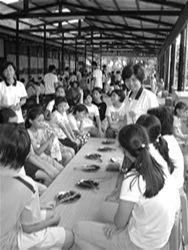
Master Sheng Yen always emphasized that Buddhists should not rely on miracles nor should they pray for them. Nevertheless, Guanyin Bodhisattva's vow of "a thousand answers to prayers at a thousand places?is a spirit that DDM members sincerely want to emulate. Guanyin Bodhisattva, through her great compassion, offers protection to all sentient beings and vows to help all sentient beings attain enlightenment. Master Sheng Yen has often expressed his hope that in addition to feeling gratitude to Guanyin Bodhisattva, all DDM members would also be the embodiment her compassion by following her vows to help sentient beings.
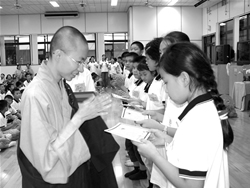
A Calm and Pure Environment for Practice
At 6:40 A.M. sharp every morning, a shuttle bus would leave Nung Chan Monastery for Dharma Drum Mountain. It brings teachers and students of CHIBS, DDM staff members, volunteers, as well as students of the Buddhist Seminary of The Buddhist Seminary of Dharma Drum Sangha University. There are also lamas from the Chinese-Tibetan Buddhist Cultural Exchange Program who occasionally visit the village.
As the shuttle bus enters the DDM center, the volunteers usually disembark at the Temporary Quarters, a name that suggests short-term usage. Though built using just sheet metal, it has been the center of all DDM activities before the completion of permanent buildings, and has been used for meditation retreats, ceremonies, camps, and so on. For example, the Chan Meditation Camp for accomplished Professionals, begun in 1992, has been held at the Quarters every year except the first. Over one thousand accomplished professionals including the Chairman of the Legislative Yuan, various business leaders, film directors, authors, architects, district attorneys, film actors and actresses, and many others have experienced calming after practicing Chan at the Temporary Quarters.
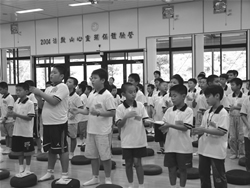
The bright and simple main hall of the Temporary Quarters radiates a solemn, peaceful, and pure ambience. The famous actress Brigitte Lin, who has twice attended Chan meditation camps at DDM, has said, "I have never seen such a peaceful, orderly, and serene place." From his time at the Quarters, film director Wu Nianzhen has realized that "practice, is really simply a way of life"
Practitioners meditate in the main hall, listen to Master Sheng Yen's teachings, stroll on the mountain trails, eat in silence, walk and sleep ... spending every moment with themselves, discovering their "self" in this calming, quiet environment. They may wonder, "What will this place, which has given us a chance to feel something we have never felt before, be like when all the building are completed?"
Simple and Humble Architectural Style
The architect Chen Bosen who was in charge of the early phase of construction, suggested that "the building should on the whole, be peaceful and blend well with the natural environment, while each segment of space would have its own beautiful scenery. Together, this presents a calming ambience for people to be able to concentrate, diligently practice, and work in."
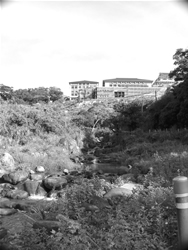
This idea was heartily approved by Master Sheng Yen. After visiting and studying Buddhist architecture in other countries, including India, Nepal, Japan, and Mainland China, and based on the characteristics of Buddhism, Chinese culture, and modern architecture, Master Shen Yen suggested that DDM's architecture should have a "modern point-of-view, reviewing historical traditions while at the same time looking forward to the future with creativity and revolution." He did not favor the traditional "palace" style, preferring instead modern technology and materials while using local styles for the design and color.
As the first phase of construction work neared completion, the Chan spirit of "original face"─as reflected in the artistic arrangement of the buildings that are simplistic and functional─could already be felt. The buildings, using brown, gray and white as the dominant colors, blend harmoniously in the surroundings, and emanate a sense of serenity and comfort that is so very inviting to all who visit. On the whole, the buildings have a simple, solemn, and open architectural style.
Blueprint of the Three Types of Education
The World Center of Buddhist Education
At the start of the first phase of the construction of DDM in 1993, Master Sheng Yen listed The Three Types of Education as:
●Education through Academics
●Education through Public Outreach
●Education through Caring Service
The Three Types of Education formed the foundation and blueprint of the overall goal of DDM.
Phase One: Relocation and Reconstruction of CHIBS
The Education and Administration Building
This is the "command center" of the DDM education system, where administrative work and classes for CHIBS, The Buddhist Seminary of Dharma Drum Sangha University, as well as the Chinese-Tibetan Buddhist cultural exchange program take place.
International Conference Hall
A system providing simultaneous translation in multiple languages is used here for international conferences.
Library and Information Center
Here, one can find forty-five different editions of the Tripitaka, precious ancient sutras written on fossils, almost five hundred international periodicals, books on various religious and secular topics, as well as multi-media and digital information.
Monks' Quarters
Housing for monks (teachers and students) of the Buddhist Seminary of Dharma Drum Sangha University.
Nuns' Quarters
Housing for nuns (teachers and students) of the Buddhist Seminary of Dharma Drum Sangha University.
Dormitory and Dining Hall for Staff
Housing for lay teachers and staff of the Chung-Hwa Institute of Buddhist Studies, including single accommodation, family accommodation, as well as a dining hall.
Reception Hall and Dining Hall (also acting as the Second Auditorium)
This is where visitors are greeted and where they can dine.
First Auditorium (also used as the Grand Buddha Hall)
The center for practice and Dharma teaching at Dharma Drum Mountain.
International Meditation Center
This includes a Chan Meditation Hall, isolated retreat cells, living quarters as well as a dining hall.
Phase Two: �Construction of Dharma Drum College of Humanities and Social Sciences
Phase Three: �Construction of Monastery, Practice Center, Nursing Home, World Buddhism History Museum, etc.
Diverse Yet Integral Global Buddhism
DDM's vision of global Buddhist education was gradually realized as Phase One was completed and as Phase Two began, in which the Education through Academics led the way. Education through Academics includes CHIBS, the Buddhist Seminary of Dharma Drum Sangha University and the Dharma Drum College of Humanities and Social Sciences. In addition, starting from September 2001, the Chinese-Tibetan Buddhist Cultural Exchange class, a course that is provided by CHIBS at the request of the Mongolian-Tibetan Committee, also became part Education through Academics.

More than two decades ago Master Sheng Yen was already advocating the importance of education for Buddhist monks and nuns. At that time, Sangha members were not as respected by the laity as they are today because they lacked quality education. Master Sheng Yen said, "If we do not start providing good education today, then there shall be no tomorrow for Buddhism." He stressed the critical need to train high quality, diligent Sangha members who are also strong in their faith, or else the future of Buddhism would be gravely endangered. Therefore, the Master led the way by establishing CHIBS, pioneering an all new academic environment of higher Buddhist education in Taiwan.
In September, 2001, as some of the buildings in the first phase of DDM construction were completed, the male Sangha members, as well as the teachers and students of the CHIBS, started moving in. Together with the formally-opened Buddhist Seminary of Dharma Drum Sangha University and the Chinese-Tibetan Buddhist Cultural Exchange class, they began their journey of learning in this brand-new educational environment.
Currently all teaching at DDM takes place in the Education and Administration Building. The research rooms are on the Sixth floor, while the fifth floor is used as classrooms for CHIBS. The Fourth floor is for the Men's Division of the Buddhist Seminary of Dharma Drum Sangha University as well as the Chinese-Tibetan Buddhist Cultural Exchange class, while the Women's Division is on the Third floor. Finally, the Wewnd floor is where state-of-the-art computerized classrooms can be found.
One of the strong impressions visitors to DDM often get is the sight of Theravadin/the Southern Tradition monks and Tibetan lamas studying at this Chinese Buddhist center. In particular, all the Tibetan lamas attending the Chinese-Tibetan Buddhist Cultural Exchange program have been recommended jointly by the Tibetan Foundation and the Mongolian-Tibetan Committee to receive Chinese education and to study Chinese Buddhism at DDM. Some of the lamas are rinpoches who are highly respected among Tibetan Buddhists, and some are geshes who have earned the equivalent of a doctorate in Buddhism. Their presence and education at DDM are truly beneficial to the advancement of exchange between Chinese and Tibetan Buddhism.
Master Sheng Yen pointed out that "diverse yet integral" global Buddhism will be the future trend for Buddhism. By diverse, he meant the coming together and greater understanding between three major Buddhist schools─Chinese, Theravada and Tibetan, while promoting greater tolerance of differences. By integral, he meant that the three schools share the central and basic Buddhist teachings: cause and effect, causes and conditions, and the concept of emptiness of nature, or sunyata, as well as the principle of having the Three Jewels as the center of the faith.
DDM's Education through Academics accepts outstanding students from different nations who are enthusiastic about studying Buddhadharma, as well as those keen on helping to spread Buddhadharma, to study together and learn from each other. From here, one can begin to foresee the future of global Buddhism.
The Library and Information Center
In addition to the traditional methods of teaching and practice, DDM's Education through Academics also makes good use of electronic technology to promote modern-day Buddhist education. The Library and Information Center which stands right across from the spiritual landmark of Dharma Drum Mountain─the seven banyan trees─provides a solid backbone to Education through Academics by archiving a large number of books, large amounts of data, as well as providing multi-functional space and facility.
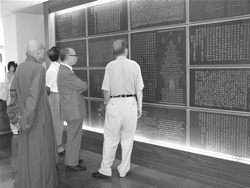
The five-story building occupies over 2,500 square meters of land. On the second floor stands the Heart Sutra Wall, on which is engraved the Heart Sutra in many languages including Chinese (two hundred and sixty words), Sanskrit, Tibetan, Korean, Japanese, Vietname-se, English, French, German, and others. In addition, there is a version in today's digital language. This wall shows the important place that the Heart Sutra with its central teaching on prajna, holds in Mahayana Buddhism. On the left side of this wall, one can see a picture of the Tripitaka Master Xuanzang of the Tang Dynasty, on his way to India to study the Buddhist sutras, as well as a picture of Master Sheng Yen holding an outdoor class. These signify that the sincere attitude in Buddhist learning has not changed over time, and they express a wish that Dharma Drum Mountain shall become a center for 21st century global Buddhism.
New collections, together with materials accumulated over time at CHIBS and CHIBC, have transformed DDM's Library and Information Center into a Buddhist library that has the most comprehensive and richest collections in Taiwan. Of special note are over three hnndred scrolls of various sutras written in Sanskrit, Thai, Burmese; the Lotus Sutra written in Tibetan and Sanskrit; the Diamond Sutra written in golden ink; the Shurangama Mantra, the Heart Sutra, and so on that are kept in the Storage Room for Special Cultural Artifacts.
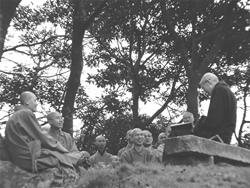
Another feature of the Library and Information Center is the digitized catalogue of books and materials stored there. Together with fifty computer terminals provided throughout the facility, users can easily search for any books or information they need.
As one contemplates the principles behind the design of the Library and Information Center, one must not neglect to notice the seven century-old banyan trees next to the building. Every spring these old trees shed their leaves, grow new buds, and eventually sprout new green leaves again, as if a colorful carnival was taking place. A considerable effort was made to ensure that these banyan trees would continue to live out their natural lives. Because Master Sheng Yen directed that the trees should remain, the size and orientation of the Library and Information Center was modified several times. Today, these old trees indeed remain and have earned the name The Seven Tathagatas as given to them by Master Sheng Yen.
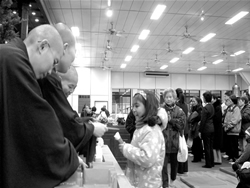 Spiritual Environmentalism in Action
Spiritual Environmentalism in Action
As Phase One of the construction neared completion, the overall design for the DDM complex began. The plan included three pilgrimage paths: the Riverside Path, the Woodland Path, and the Trail Path. New greenery was planted around the buildings, while over nine hundred native trees, originally occupying the land on which the Dharma Drum College of Humanities and Social Sciences was to be built, were carefully transplanted to other locations at the complex, so that they could continue to thrive in suitable soil and weather conditions.
At the same time, planning began to conserve precious water resources in the mountain. Reservoirs were built to conserve water, and water wheels were made to efficiently deliver water for various functions over the whole complex, such as irrigation, cleaning, and so on.
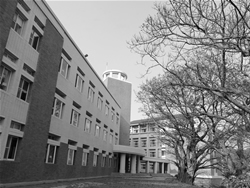
In addition, as soon as the first phase of the construction work was completed, courses on spiritual environmentalism commenced, teaching visitors how to experience peace in both body and mind. In order to benefit most visitors, courses of various lengths, from one-two hours up to one-two days, will be offered. It is hoped that visitors to DDM will go home with something precious and useful; in particular, via The Three Types of Education, that they will take with them methods for cultivating the spiritual treasures in their own mind.